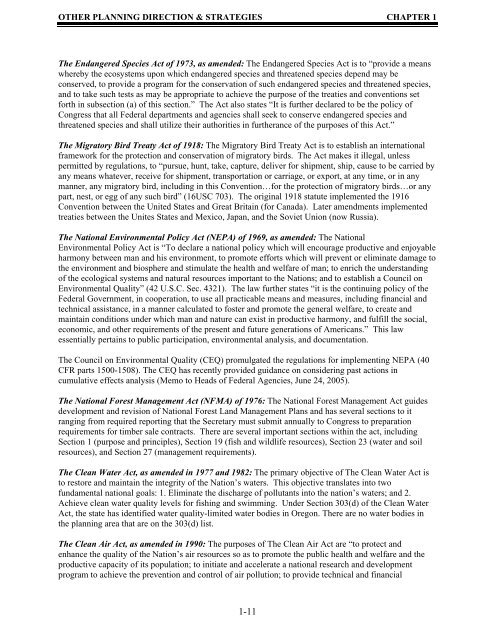Environmental Assessment
Environmental Assessment
Environmental Assessment
You also want an ePaper? Increase the reach of your titles
YUMPU automatically turns print PDFs into web optimized ePapers that Google loves.
OTHER PLANNING DIRECTION & STRATEGIES CHAPTER 1<br />
The Endangered Species Act of 1973, as amended: The Endangered Species Act is to “provide a means<br />
whereby the ecosystems upon which endangered species and threatened species depend may be<br />
conserved, to provide a program for the conservation of such endangered species and threatened species,<br />
and to take such tests as may be appropriate to achieve the purpose of the treaties and conventions set<br />
forth in subsection (a) of this section.” The Act also states “It is further declared to be the policy of<br />
Congress that all Federal departments and agencies shall seek to conserve endangered species and<br />
threatened species and shall utilize their authorities in furtherance of the purposes of this Act.”<br />
The Migratory Bird Treaty Act of 1918: The Migratory Bird Treaty Act is to establish an international<br />
framework for the protection and conservation of migratory birds. The Act makes it illegal, unless<br />
permitted by regulations, to “pursue, hunt, take, capture, deliver for shipment, ship, cause to be carried by<br />
any means whatever, receive for shipment, transportation or carriage, or export, at any time, or in any<br />
manner, any migratory bird, including in this Convention…for the protection of migratory birds…or any<br />
part, nest, or egg of any such bird” (16USC 703). The original 1918 statute implemented the 1916<br />
Convention between the United States and Great Britain (for Canada). Later amendments implemented<br />
treaties between the Unites States and Mexico, Japan, and the Soviet Union (now Russia).<br />
The National <strong>Environmental</strong> Policy Act (NEPA) of 1969, as amended: The National<br />
<strong>Environmental</strong> Policy Act is “To declare a national policy which will encourage productive and enjoyable<br />
harmony between man and his environment, to promote efforts which will prevent or eliminate damage to<br />
the environment and biosphere and stimulate the health and welfare of man; to enrich the understanding<br />
of the ecological systems and natural resources important to the Nations; and to establish a Council on<br />
<strong>Environmental</strong> Quality” (42 U.S.C. Sec. 4321). The law further states “it is the continuing policy of the<br />
Federal Government, in cooperation, to use all practicable means and measures, including financial and<br />
technical assistance, in a manner calculated to foster and promote the general welfare, to create and<br />
maintain conditions under which man and nature can exist in productive harmony, and fulfill the social,<br />
economic, and other requirements of the present and future generations of Americans.” This law<br />
essentially pertains to public participation, environmental analysis, and documentation.<br />
The Council on <strong>Environmental</strong> Quality (CEQ) promulgated the regulations for implementing NEPA (40<br />
CFR parts 1500-1508). The CEQ has recently provided guidance on considering past actions in<br />
cumulative effects analysis (Memo to Heads of Federal Agencies, June 24, 2005).<br />
The National Forest Management Act (NFMA) of 1976: The National Forest Management Act guides<br />
development and revision of National Forest Land Management Plans and has several sections to it<br />
ranging from required reporting that the Secretary must submit annually to Congress to preparation<br />
requirements for timber sale contracts. There are several important sections within the act, including<br />
Section 1 (purpose and principles), Section 19 (fish and wildlife resources), Section 23 (water and soil<br />
resources), and Section 27 (management requirements).<br />
The Clean Water Act, as amended in 1977 and 1982: The primary objective of The Clean Water Act is<br />
to restore and maintain the integrity of the Nation’s waters. This objective translates into two<br />
fundamental national goals: 1. Eliminate the discharge of pollutants into the nation’s waters; and 2.<br />
Achieve clean water quality levels for fishing and swimming. Under Section 303(d) of the Clean Water<br />
Act, the state has identified water quality-limited water bodies in Oregon. There are no water bodies in<br />
the planning area that are on the 303(d) list.<br />
The Clean Air Act, as amended in 1990: The purposes of The Clean Air Act are “to protect and<br />
enhance the quality of the Nation’s air resources so as to promote the public health and welfare and the<br />
productive capacity of its population; to initiate and accelerate a national research and development<br />
program to achieve the prevention and control of air pollution; to provide technical and financial<br />
1-11
















